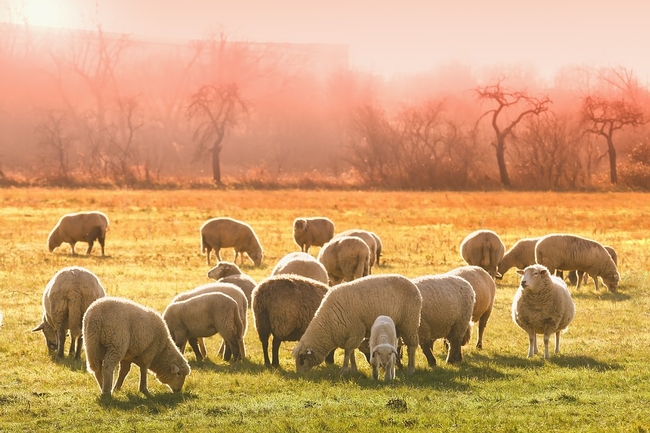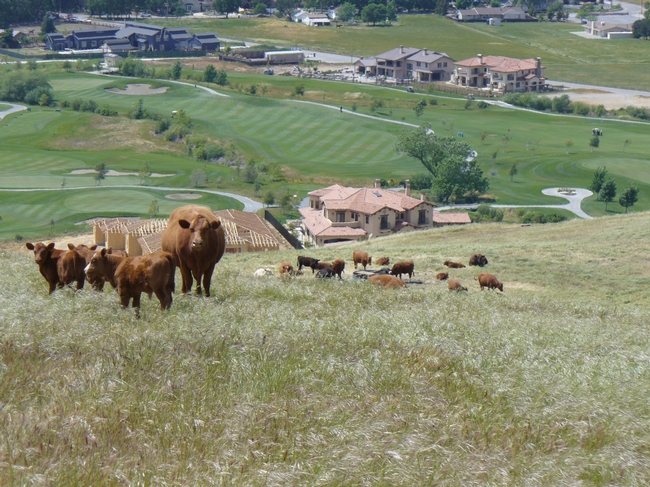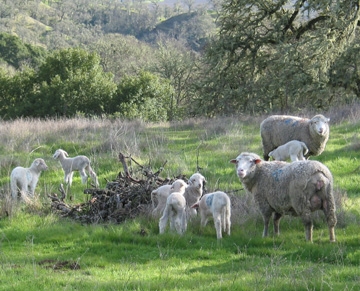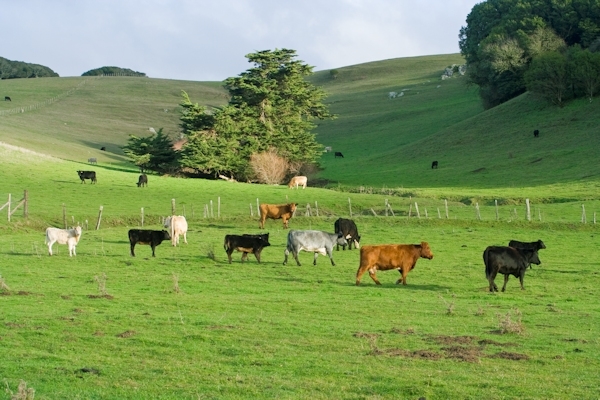
Along with prescribed fire, grazing of domestic livestock may be the earliest vegetation management tool employed by humans. We suggest that the challenges of vegetation management on working landscapes may be addressed with the careful sharpening of this old tool. Prescription grazing is the application of livestock grazing at a specified season, duration and intensity to accomplish specific vegetation management goals. Controlled grazing of this type is being employed throughout California on public and private land and is proving to be a promising tool in reducing the fire fuels and unwanted, excessive vegetation.
Furthermore, livestock grazing has one distinct advantage over other control methods; in the process of controlling an undesirable plant, grazing animals convert it into a saleable product.
Steps in Developing a Grazing Prescription

Selecting the Right Species
The species of livestock best suited for the specific vegetation management goals depends on both the plant species of concern and the production setting. Cattle have large rumens that are well adapted to ferment fibrous material and are classified as grass and roughage eaters. They are therefore generally superior to goats or sheep to manage fibrous herbaceous vegetation such as dormant grasses. Goats have narrow and strong mouths well designed for stripping individual leaves from woody stems and for chewing branches. Goats also have a large liver mass relative to cattle or sheep and may therefore more efficiently process plants that contain secondary compounds such as tannins or terpenes. Sheep are generally considered an excellent species to accomplish control of herbaceous weeds. Sheep possess a narrow muzzle and a relatively large rumen per unit body mass. These characteristics allow them to selectively graze and yet tolerate substantial fiber content, and results in diets generally dominated by forbs. Sheep are also small, sure-footed, and well suited for travel in rough topography which may not be easily accessible for chemical weed control.
Grazing Workshops for Working Landscapes in Sonoma & Marin Counties
Creating resiliency in the rural landscape of Sonoma and Marin Counties is critical in preparing for the next natural disaster, managing biodiversity or achieving ecosystem service goals such as carbon sequestration, wildlife habitat and viewsheds. This growing recognition of the ecological benefits livestock grazing is important to our County's resiliency. However, grazing can be difficult to landowners that have never grazed their properties before. UC Cooperative Extension will hold several workshops on prescriptive grazing techniques to address the sustainability of our working landscapes while reducing the vegetation that leads to catastrophic wild fires. Private land owners manage the majority of the open spaces in Sonoma and Marin Counties and these workshops are aimed at those private citizens and other public land owners that are interested in using grazing as a vegetation management tool. Increasing the number of agriculture land grazed will benefit both public and private open space and the residents that benefit from them. The goal of the workshops is to increase understanding, interest and acceptance of using grazing as a vegetation management tool. Upcoming workshop held at SRJC Shone Farm: 
DAY 1 – FRIDAY, May 17 (8:30 am - 7pm)
- Setting Achievable Grazing Goals
- Basic Principles of Managed Grazing
- Animal Nutrition, Body Condition Scoring
- Selecting the right grazer
- Animal Husbandry Basics
- Grazing 101
- Electric Fencing
- Drought & Flood Management
DAY 2 – SATURDAY, May 18 (8: 00 am - 5 pm)
- Graze Planning
- Infrastructure
- Pasture & Range Ecology
- Livestock Protection Tools
- Health Issues-Parasite Control
- Livestock Economics, Leasing
- Carbon Plan
- Monitoring, meeting grazing goals
Register online for
Grazing School for Vegetation Management & Wildfire Vegetation Reduction.
Sonoma and Marin County's working landscapes, properly managed with prescription grazing, could prove to be a winning solution for all parties involved. Grazing not only provides a service to land owners and managers that may not be easily achieved in other ways, but it can also provide an income stream to aspiring livestock grazers just starting their grazing businesses. These workshops will provide educational opportunities for all parties to learn the “how to” in grazing, landowners who what to graze themselves, landowners who want to hire grazes and grazers who are looking to start or increase their grazing business enterprise. Let's work together to sharpen the “old” tool of “livestock grazing” into the “new vegetation management tool” for working landscapes.
Attached Images:
